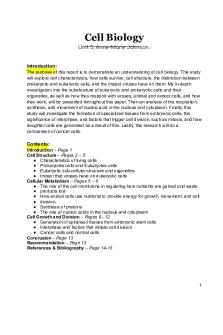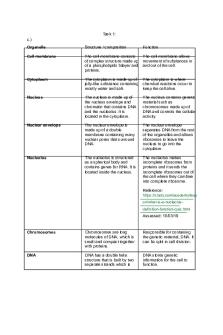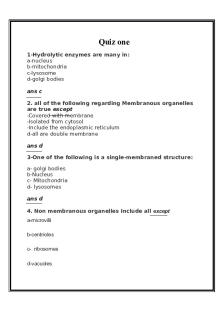Unit 5- Cell Biology - Grade: PASS PDF

| Title | Unit 5- Cell Biology - Grade: PASS |
|---|---|
| Author | Jess Marie |
| Course | Cell Biology |
| Institution | Distance Learning College |
| Pages | 17 |
| File Size | 971.5 KB |
| File Type | |
| Total Downloads | 77 |
| Total Views | 176 |
Summary
unit 5 of access to nursing...
Description
Unit 5: Cell Access to Nursing Biolog By Jessica Hardy y
Unit 5- Cell Biology
By Jessica Hardy -Title Page -Introduction -Contents -title page -introduction -contents -cell structure -cellular metabolism -cell growth and reproduction -conclusion - recommendations -references -Bibliography Table on eukaryotic cells and prokaryotic cells … diagrams for all ¾
https://basicbiology.net/biology-101/introduction-to-cells https://sciencing.com/living-cell-characteristics-7464841.html
Introduction This report demonstrates the understanding of cell biology, the purpose is to identify the difference in characteristics within living cells, how they can survive, compare Eukaryotic and prokaryotic cells, the structure of cells and what impact it will have if the cells are affected by cancer and other viruses. This report will portray in depth research into the substructure of cells and their organelles, it will be viewed further into how animal cells react and work compared to human cells. I would then produce an analysis into the movement of what nucleic acid plays within the nucleus and the cytoplasm, this would also include the respiration of the cell. It will show a report of specialised tissues from embryonic cells and the importance of interphase and the factors that initiate of cell division, and research into how daughter cells can be produced from this and compare cancerous cells.
Characteristics of living cells A cells importance is to keep an organism functioning and alive, every living thing is made up of more than one cell so therefore there is a wide variety of difference within cells but many have common characteristics. Mainly most cells are built up with a genetic material such as the membrane and a cytoplasm, other features a cell can contain are organelles and ribosomes that preforms specific functions. Many living cells only contain one cell which are called single-celled or unicelled organisms, single cells are responsible for helping to function all important areas of the cell, one example of this is bacteria as these are single celled. All cells can be placed within two sectors which are called Eukaryotic and Prokaryotic, Eukaryotic are living cells that are found in animals, plants, fungi and protists, these are known to be domain Eukaryote. Prokaryotic can be found within bacteria and archaea, these cells do not have a nucleus or organelles whilst Eukaryotic do. Living organisms can also control their internal conditions such as temperature and water content. Every Living organism will share a variety of important characteristics and functions which are placed in categories such as sensitivity, order, environment, reproduction, growth, regulation, homeostasis and energy processing. All these characteristics serve a purpose to define life or living thing. Below I will include a small statement about each characteristic and what they have in common. Movement- All cells can move and change their position; this gives the cells the opportunity to catch food and avoid been prey to other organisms. Sensitivity- They can all sense stimuli and can respond to them, this can help them protect themselves and adapt to changes within the environment. Reproduction- They can reproduce themselves (organisms) and comes within two forms which are asexually or sexually. Asexually is the creation of two organisms from an existing one through cell division, the other is sexually which can be two organisms reproducing. Growth- By changing the number of cells, they can increase their dry mass, growth factors are where protein attach to the cell’s environment such as the plasma membrane which direct them to further grow. Cells normally grow until a certain size then finish, this can happen due to intrinsic and extrinsic factors, growth factor can cause the cell the grow without encouraging them to divide. Some cells may be included within the immediate environment which can grow into the cellular to help influence the growth of other cells, this example could be used when understanding the repairing of a wound. If another cell grows and touches the membrane it can affect the growth occurring and could stop the process
Pamela McKellar (Date unknown) “Cells and organisms” available at https://www.pinterest.com/pin/539728336582728912/ Accessed 12th of April 2021
altogether, specific cells can contain genes which are located within the cell to help the synthesis of proteins which can pause the growth. When these cells are unchecked, this can result into cancerous tumour, the national centre of Biotechnology information states this to be true. Respiration- They can excrete substances and waste toxins; they can break down sugars with the use of oxygen through the process of respiration. It can convert energy from fats and carbohydrates into energy. Nutrition- They can absorb nutrients, mineral iron and organic substances, these will contain the correct nutrients and raw materials needed to grow as well as create tissue repair, the key for survival.
www.quora.com/cellbiology
Prokaryotic cells and Eukaryotic cells
Prokaryotic cells Bacteria are amongst the simplest of organisms - they are made of single cells. Their cell structure is simpler than the cells of eukaryotes and cells are smaller, most are 0.2 μm - 2.0 μm These cells do not contain membrane bound organelles such as a nucleus and mitochondria. Bacterial cells are called prokaryotic cells. (Bitesize 2020). I have enclosed a diagram of one of these cells to shows what they look like.
Photographer unknown (2016), “Cell Structures” Available at https://www.bbc.co.uk/bitesize/guides/z84jtv4/revis ion/11 Accessed 12th of April 2021 Photographer unknown (2016) “Cell Structures” Available at https://www.bbc.co.uk/bitesize/guides/z8 4jtv4/revision/11 Accessed 12th of April 2021
Eukaryotic cells
Eukaryotic cells are cells that contain a nucleus and organelle’s and are enclosed by plasma membrane. Organisms that have eukaryotic cells include protozoa, fungi, plants and animals. I have enclosed a basic diagram of one of these cells to show what they look like. These are larger and more complex compared to the prokaryotic cells, this can be found within the archaea and bacteria which are the two domains.
Comparison
I found due to research that the primary distinction between these two types of organisms is that eukaryotic cells have a membrane bound nucleus and prokaryotic cells do not. Prokaryotes have no membrane-bound organelles. Another important difference is the DNA structure. I have found the similarities between both cells, each type of cell has a lipid bilayer which is arrangement of proteins that acts as a barrier between internal and external environments, this is important within the cell membrane. Both eukaryotic and prokaryotic cells use deoxyribonucleic acid which is found within DNA, this is needed regulate and keep the function through creation of RNA and is followed by proteins. Ribosomes is found to help the creation of protein and function of the cell in both cells. The cytoplasm is found as the primary place for biochemical reactions. In Eukaryotic cells the cytoplasm comprises between the plasma membrane and nuclear including organelles. In prokaryotic cells the cytoplasm comprises everything within the plasma membrane including the cytoskeleton and genetics. Eukaryotic cells are found within animals and plants whereas prokaryotic cells are found within bacteria. I have displayed a table I found within my research, this shows what each cell has similar and the differences.
Website: (Available from) https://www.visiblebody.com/learn/biology/cells/ prokaryotes-vs-eukaryotes Accessed on 10th of April 2021 Virus’s
Prokaryotic and Eukaryotic cells are both living cells whilst viruses are not, virus have some organelles which is similar to prokaryotic cells, they contain plasma membrane, cell wall, RNA or DNA and protein. When a virus comes with on contact with a cell, It can insert genetic material within and take over all the cell functions. An infected cell will produce viral protein and genetics instead, virus can cause a number of diseases within a Eukaryotic cell. Viruses are like parasites that need a host of cells to be able to reproduce, Eukaryotic are human cells which can cause complications whilst prokaryotic can be bacteria which means they are similar. ‘A virus can take on a variety of different structures. The smallest virus is only 17 nanometres, barely longer than an average sized protein. The largest virus is nearly a thousand times that size, at 1,500 nanometres. This is really small. A human hair is approximately 20,000 nanometres across. This means that most virus particles are well beyond the capability of a normal light microscope.’ The diagram I have included is an Ebola infected cell, I found this on a website and believe the diagrams shows the cell purpose effectively. The structure of a virus is dependent upon which species serves as its host. A virus which replicates in mammalian cells will have protein coats which enables this to attach to and infiltrate mammalian cells. The shape, structure, and function of these proteins’ changes depending on the species of virus. Animal Feature Plant cell Prokaryotic cell cell Nucleus
✔
✔
×
Cell membrane
✔
✔
✔
Cytoplasm
✔
✔
✔
Cell wall
×
✔
✔
Vacuole
×
✔
×
Chloroplasts
×
✔
×
Plasmids
×
×
✔
DNA free in cytoplasm
×
×
✔
Website: “Virus” (Found online from) https://biologydictionary.net/virus/ Accessed 11th April 2021
Eukaryotic subcellular structure and organelles Eukaryotic cells contain a variety of membrane organelles, these structures play an important role within the functioning of a cell, this includes constructing and exporting new molecules to protect the cell from invaders (virus’s), they also have a nucleus within the cell membrane.
Cell membrane Cell membranes are composed of fatty acids have based lipids and proteins; it is also known as the plasma membrane. These are found in all cells and separates the interior of the cell from the environment, the membrane helps transport materials entering exiting the cell, they are building blocks for an organism. Some organisms are made from one cell and are known as a unicellular and others who are built up of more are called multicellular organism. Both unicellular and multicellular are separated from one another by a barrier which is the cell membrane or plasma membrane. I have displayed a diagram below of the cell membrane and how it is formed and where the functions are located. Website: (online from) https://biologydictionary.net/cell-membrane/ Accessed 11th April 2021
Kalleyanee naloka (2017) “Cytoplasm membrane structure” Available at: https://www.shutterstock.com/imagevector/cell-membrane-cytoplasmicstructure-1106910629 Accessed on 14th of April 2021
The cell membrane excretes waste and gain nutrients by transferring substances, a membrane can do this with different ways depending on the nature of the substance. Below are some ways the cell membrane can do this: Facilitated diffusion is diffusing molecules through the plasma membrane with the help of membrane proteins such as carriers, a concentration exists within these molecules so therefore they have the advantage of diffusing the cell by moving down it. Membrane lipids is where a group of compounds which have a similar structure to oils and fat and have double layer surfaced of the cells known as the lipid bilayer. The three types of membrane lipids are phospholipids, glycolipids and cholesterol. Lipid diffusion is used for steroid transportation. The Lipid bilayer allows small substances such as oxygen, carbon dioxide, and hydrophobic molecules to pass through the cell membrane and then pass down their concentration gradient into simple diffusion.
Sagar Aryal (2009) “Passive Transport” Available at https://microbenotes.com/passive-transport/ Accessed on 16th of April 2021
Passive Transport can occur when molecules diffuse through the cell membrane by passing through transporting proteins. The transportations happens when a high concentration molecule travels to the lower concentration. Passive transport is a type of membrane that does not need energy to move substances around.
Active transport cell membrane is an active transport movement between molecules through the cell membrane from a lower concentration region to a higher concentration area, this
process would require cellular energy to create movement. The three types of membrane transport is passive diffusion, facilitated diffusion and active transport. (Wikipedia)
Photographer unknown (2011) “passive transport” Available: http://hyperphysics.phyastr.gsu.edu/hbase/Biology/actran.html Accessed on 18th of April
Vesicular transport Vesicular transport is the exchange of proteins and lipids between the organelles and the cell membrane within Eukaryotic cells, there is Golgi-derived and COPI-coated vessels involved in numerous vesicular transporting steps. This would include the bidirectional transport within the Golgi and recycling this within the ER. I have included a diagram to portray more understanding.
E.V.WONG (2015) “Vesicular Transport” Available at https://bio.libretexts.org/Bookshelves/Cell_and_ Molecular_Biology/Book%3A_Cells__Molecules_and_Mechanisms_(Wong)/11%3A_ Protein_Modification_and_Trafficking/11.06%3A _Vesicular_Transport Accessed on 19th of April
Cell respirations This is a type process where organisms combine oxygen with foodstuff molecules, they would divert chemical energy in these substances and into life sustaining activities such as waste products, oxygen and carbo dioxide. ATP is created within the respiration process and can be hydrolysed into ADP/PI with the use of active transport, ATP is vital within the cells overall survival as it will help realise energy when it is required within chemical reactions. It is dependent on tropic levels of food to help with the energy sources needed for chemical changes called ATO. Glucose is a main substate to help the respiration process and it could also use other liquids and protein within this process, energy can be saved for later use. There are three steps within the respiration process which are1. Glycolysis- This will occur within the cytoplasm and can happen with or without oxygen. 2. Krebs Cycle- This can be complex part for biochemical pathways, this occurs within the mitochondria and is a number of chemicals reactions to release stored energy (BD editors 2019). 3. Electron transport- This is the final stage of respiration; this can occur within the inner membrane of the mitochondria.
Mr Baclebush (2008) “The cell respirations process” Available https://quizlet.com/271984388/cellularrespiration-diagram/ Accessed on 20th of April 2021
Transcription This is a type of process where information in a strand of DNA Is copied within a new molecule (RNA) which is a type of messenger. RNA begins with mRNA synthesis by matching bases to the original DNA. Transcription happens within the nucleus and the hydrogen bonds would break between the bases of DNA molecule, and this can cause unwinds. The free RNA nucleotides pair with exposed DNA strands the sugar phosphate can bond cytosine with guanine and adenine bonds with thymine with the DNA but uracil within RNA. The single stand that is formed is a strained molecule and this can be called the messenger RNA. Activation
The activation process occurs within the cytoplasm and this would include free amino acids and could transfer RNA. The amino acids would bind with TRNA and within this process specific enzymes and this would require the source of energy. TRNA have three unpaired bases that are known as anti-Condon. Translation This process occurs within the ribosomes and this is where the MRNA attaches itself to the larger subunit which are one of the first three AUG, these are called adenine, uracil and guanine structure. TRNA construct amino acids of methionine and this would always be first within the polypeptide chain. After this the TRNA molecule will bind the remaining three on a complimentary basis of anti-conden, this would then introduce the second amino acid although this would depend on which TRNA were involved within these bonds.
Animal cells Animals process nutrients in order to provide energy for metabolic activities, such as growth and movement. For example, glucose is a product that has been broken down and then enters glycolysis and the Krebs cycle in order to carry out respiration. Respirations produces ATP through these processes and oxidative phosphorylation. Then ATP is used to provide energy for all sort of reactions so that the animal cell can grow and move. The main source of energy for animals are carbohydrates and glucose, known for body fuel. When carbohydrates are digested within an animals diet then are then converted into glucose modules and turned into energy through numerous catabolic chemical reactions, it is found adenosine triphosphate or the ATP as a primary source within cells.
The functions of an animal cell 1. The cells control the processes in the body efficiently. 2. Cells control synthesis and storage of energy. 3. Cells perform and control the Replication, Translation, and transcription of DNA. 4. Cells are extremely dedicated to carrying out precise responsibilities. 5. Red blood cells encompassed of Haemoglobin. Haemoglobin is the cells which did not contain any nuclei and its main function is to transfer oxygen throughout the whole body. 6. Analogous tissues assembled and form the organs of the body, like lungs, brain and heart. Inside the human body, ciliary cells are present in the Digestive Tract which increase the surface area and help in the process digestion. 7. Numerous cells syndicate and form Tissues. Which perform a specialised function in
the human body.8. Inside the human body, ciliary cells are present in the Digestive Tract which increase the surface area and help in the process digestion.
Regina Bailey (2014) “The functions of an animal cell” Available https://www.thoughtco.com/all-about-animalcells-373379 Accessed on 20th of April 2021
Nucleolus acid Nucleolus acids are present in every form of life and are essential biomolecules, it is present in all organisms from bacteria and animals to viruses and humans. Nucleic acids range in a variety sizes from small biomolecules to large biopolymers, they are made up of repetitive subunits called nucleotides. The word nucleic acid is used in DNA and RNA. (https://alevelbiology.co.uk/notes/nucleic-acids/) Anne Marie Helmenstine (02 February 2020) Available at: https://www.thoughtco.com/dnaversus-rna-608191 Accessed on 21st of April
RNA is also present is in all living cells, this is the most important nucleic acid live within living things, it is ribonucleotides with ribose as pentose sugar. Transfer RNA (Trna) The transfer of RNA amino acids to ribosomes so that can be assembled into proteins, the RNA reads code on the messenger (mRNA), this will carry amino acids to ribosomes and
can be transferred to the right proteins. The messenger RNA present in cells and an essential component with ribosomes are present within bacteria and eukaryotic cells. Ribosomes arrange themselves into two subunits, the larger ribosomes and smaller subunit and the structure of these two subunits differs in eukaryotes ad prokaryotes.
DNA Replication This is the process of DNA that is copied to be created, strands are separated exposing nucleotides, it is found that a new daughter DNA strand wi...
Similar Free PDFs

Unit 5- Cell Biology - Grade: PASS
- 17 Pages

Cell Biology unit (5)
- 14 Pages

Unit 5 Cell Biology
- 18 Pages

Unit 5 cell biology assignment
- 17 Pages

Unit 1 Cell Biology - notes
- 5 Pages

Cell biology
- 3 Pages

Grade Quiz Unit 5
- 12 Pages

Cell Biology Quiz CELL ORGANELLES
- 10 Pages

Shopee-pass - Grade: B
- 23 Pages

MKT portfolio - Grade: pass
- 6 Pages

Task 4 - Grade: pass
- 5 Pages

Task 2 - Grade: Pass
- 14 Pages
Popular Institutions
- Tinajero National High School - Annex
- Politeknik Caltex Riau
- Yokohama City University
- SGT University
- University of Al-Qadisiyah
- Divine Word College of Vigan
- Techniek College Rotterdam
- Universidade de Santiago
- Universiti Teknologi MARA Cawangan Johor Kampus Pasir Gudang
- Poltekkes Kemenkes Yogyakarta
- Baguio City National High School
- Colegio san marcos
- preparatoria uno
- Centro de Bachillerato Tecnológico Industrial y de Servicios No. 107
- Dalian Maritime University
- Quang Trung Secondary School
- Colegio Tecnológico en Informática
- Corporación Regional de Educación Superior
- Grupo CEDVA
- Dar Al Uloom University
- Centro de Estudios Preuniversitarios de la Universidad Nacional de Ingeniería
- 上智大学
- Aakash International School, Nuna Majara
- San Felipe Neri Catholic School
- Kang Chiao International School - New Taipei City
- Misamis Occidental National High School
- Institución Educativa Escuela Normal Juan Ladrilleros
- Kolehiyo ng Pantukan
- Batanes State College
- Instituto Continental
- Sekolah Menengah Kejuruan Kesehatan Kaltara (Tarakan)
- Colegio de La Inmaculada Concepcion - Cebu



